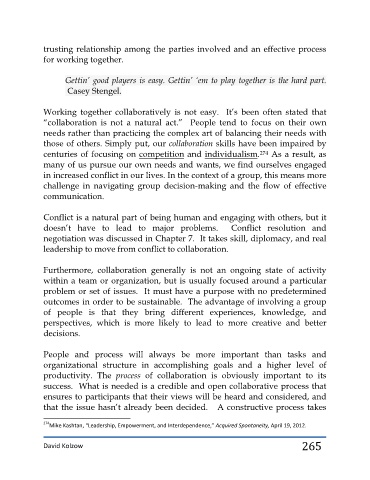Page 265 - 4- Leading_from_Within
P. 265
trusting relationship among the parties involved and an effective process
for working together.
Gettin’ good players is easy. Gettin’ ‘em to play together is the hard part.
Casey Stengel.
Working together collaboratively is not easy. It’s been often stated that
“collaboration is not a natural act.” People tend to focus on their own
needs rather than practicing the complex art of balancing their needs with
those of others. Simply put, our collaboration skills have been impaired by
centuries of focusing on competition and individualism. 274 As a result, as
many of us pursue our own needs and wants, we find ourselves engaged
in increased conflict in our lives. In the context of a group, this means more
challenge in navigating group decision-making and the flow of effective
communication.
Conflict is a natural part of being human and engaging with others, but it
doesn’t have to lead to major problems. Conflict resolution and
negotiation was discussed in Chapter 7. It takes skill, diplomacy, and real
leadership to move from conflict to collaboration.
Furthermore, collaboration generally is not an ongoing state of activity
within a team or organization, but is usually focused around a particular
problem or set of issues. It must have a purpose with no predetermined
outcomes in order to be sustainable. The advantage of involving a group
of people is that they bring different experiences, knowledge, and
perspectives, which is more likely to lead to more creative and better
decisions.
People and process will always be more important than tasks and
organizational structure in accomplishing goals and a higher level of
productivity. The process of collaboration is obviously important to its
success. What is needed is a credible and open collaborative process that
ensures to participants that their views will be heard and considered, and
that the issue hasn’t already been decided. A constructive process takes
274
Mike Kashtan, “Leadership, Empowerment, and Interdependence,” Acquired Spontaneity, April 19, 2012.
David Kolzow 265

